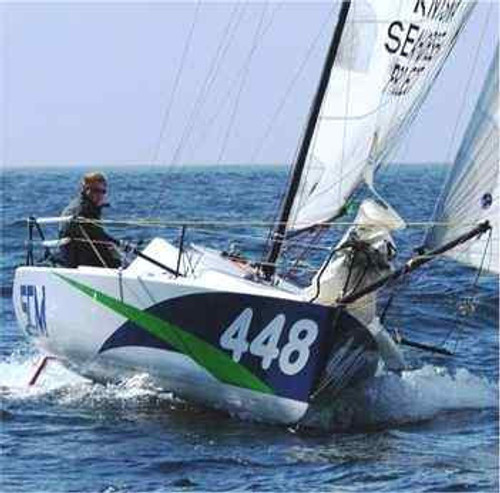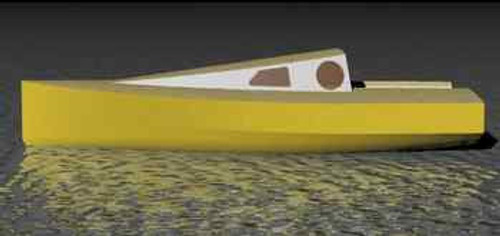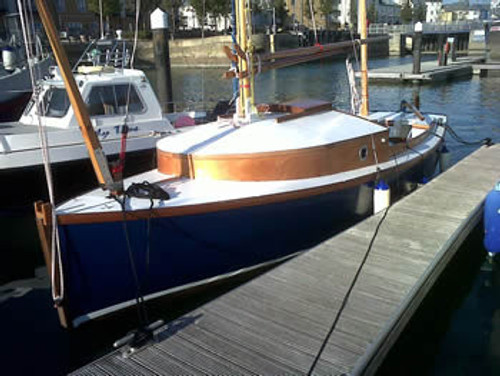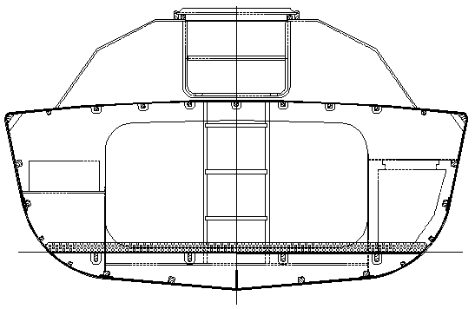
Compact performer
~ Based on Didi 26
~ Economy of plywood
~ Radius chine hull, stitch & glue cabintop
~ Round bilge from sheet material
~ Within abilities of amateur builders
~ Easily handled fractional rig
~ Two rig options
~ High performance racing for Dad
~ Comfortable weekending for the family
The Didi 26 is our most popular small keelboat design, with well over 100 plan sets sold and launchings occurring regularly. Over the years that we have been selling it, I have been asked often if we have a similar concept available in a smaller size. Now we can offer just that, in the new Didi 23. This is a contracted version of her bigger sister but maintains beam and height, so that the interior retains comfort and functionality for weekending.
The result is a boat that is 12.5% shorter and lighter than the Didi 26 and with the rig reduced proportionately. This should give a cost saving of about 15%. It will also be easier to launch and retrieve because of reduced weight.
Simple Plywood Construction
Construction detailing and scantlings are the same as for the Didi 26, so the Didi 23 will be a robust little boat. Keel loads are carried by bulkheads and the structure of the keel box. The backbone is also of plywood, on edge, slotted through the bulkheads as a self-jigging eggcrate arrangement to assist setting up the framework. All of these parts are plywood and epoxy filleted together, making for simplified construction.
Assembly of the hull follows the principles of model aeroplane construction, with stringers slotted into the bulkheads for attachment of the skin. The hull skin is single skin plywood to the sides and bottom and the radius is done in two layers.
Deck construction is done in a similar way, all in single skin plywood. The cabintop is designed with a multi-chine skin and is assembled over the bulkheads by the stitch and glue method for a strong and lightweight structure.
Suggested plywood for construction is okoume (gaboon) ply throughout. Epoxy coated and painted inside and out to hull and deck, a good standard of finish is achievable with little or no fairing aside from forming fillets at internal angles. The addition of a layer of glass fabric to the outside will give increased resistance to knocks but will add weight and require fairing, thereby adding a fair amount to construction time and cost.
Two Keel Options
The standard keel is a vertical dropkeel with a 350kg bulb on the end of the high aspect foil. It is lifted by a tackle system led to a cabintop winch. Fully retracted, the bulb remains below the hull, with a draft of 0,5m. Sailing draft is 1.7m. The bulb can be done in either a simple vertical sided foil section for owner casting or a torpedo shape for professional casting.
We have a fixed keel option as well. This uses a hollow aluminum casing for the foil, constructed over tubular inner framing and fitted with the same bulb options as the lifting keel. The casing is bolted through the hull bottom to an aluminum support box, which is bolted to the internal structure of the hull.
Rudder options are a fixed blade or a rudder box with daggerboard blade. Both are transom hung on conventional pintles.
The cockpit and bridgedeck together are 2.6m long, giving plenty of space for working the boat while racing or socialising or sunning when cruising. The only winches on the boat are a pair of 16:1 self-tailers on the cabintop. They are located where they can be operated from the companionway, the bridgedeck or the weather rail. They are oversized to ease keel handling so sail trimming will be a cinch.
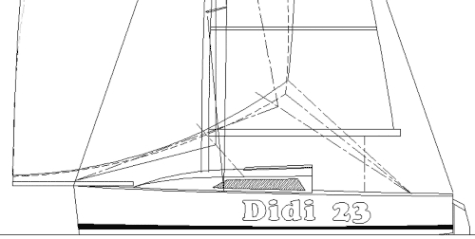
Easily Handled Rig
The rig is deck stepped on a hinged foot, fractional with two sets of swept spreaders. This makes her easy to handle with a small crew whether racing or cruising. Shrouds go to outboard chainplates to minimise rig loadings. The working headsails are non-overlapping and sheet inside the shrouds. A light drifter can be flown outside the shrouds and sheets to the spinnaker blocks on the quarters.
The fractional and masthead spinnakers are asymmetric, set on a retractable pole on the foredeck. The inboard end is fitted on a radiused transverse track to allow the outboard end to be projected up to weather for sailing at deeper angles. Extension and retraction of the pole can be done from either rail, with the pole retracting to whichever side is convenient at the time.
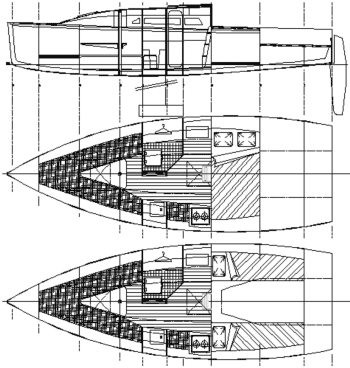
Weekending or racing accommodation
Down below she has sitting headroom throughout, with two layout alternatives. She has a small galley with two-plate cooker, sink, icebox and a seat for the cook. The dropkeel casing forms one side of the enclosed heads compartment, which includes a bin type wet locker. The dinette table drops to convert the pair of single V-berths into a double. The prime berth in the short cockpit version is a large transverse double under the bridgedeck, great for use on moorings or at anchor. Aft is loads of storage space accessible from the berth.
The long cockpit version has identical accommodation forward of the cockpit but replaces the large transverse double berth with two conventional quarter berths.
Auxiliary power is provided by an outboard clamped to the transom. An internal saildrive option is also included on the drawings.

Full Size Patterns
Included in the stock plan package are full size patterns of the backbone and various other components, plotted onto Mylar film on our large format inkjet roll plotters. Bulkhead shapes are simple and easily set out from clear diagrams, the setting out taking about 2 to 3 hours per bulkhead. For those who would prefer to have full size patterns for the bulkheads, we can also supply them for an additional
50% on the stock plan price. Choose the building option to suit your own needs. Whichever route you choose, we will be available to assist with advice if any problems arise.

Cruising Rig Option
~ Detuned rig for cruising or stronger wind areas
~ Fully inter-changeable with tall rig
~ Mainsail excl roach = 13.44sq. m (145sq. ft)
~ Sail Area Main + Jib = 22.21sq. m (239sq. ft)
~ SA/Displ = 18.84
~ SA/WS = 1.84
~ P = 7.88m (25'10")
Bill Of Materials
CHIPBOARD (for setting out bulkheads if building from offsets)
1,83x2,74m (6'x9') 16mm (5/8") - 1 sheetMARINE PLYWOOD 1,22x2,44m (4'x8') (preferably Gaboon or Okoume plywood)
4.5mm (3/16") - 6 sheets (use 4mm if 4.5mm is not available)
6mm (1/4") - 4 sheets
9mm (3/8") - 20 sheets
12mm (1/2") - 6 sheets
SAWN PINE (for building stocks etc)
25X125mm (1"x5") (rails) - 18m
50x50mm (2"x2") (bulkhead legs) - 15m
75x75mm (3"x3") (posts) - 8m
CEDAR or similar, selected, free of knots, shakes fractures etc
12x22mm (1/2"x 7/8") (washboard slides) - 5m (17')
22x22mm (7/8"x7/8") (radius stringers, deck stringers, joinery cleats) - 89m (292')
22x22mm (7/8"x7/8") Triangular fillets (keel box, cockpit) - 16m (53')
22x32mm (7/8"x1 1/4") (bulkhead cleats) - 4m (14')
22x44mm (7/8"x1 3/4") (berth bearers, beams, hatch slides) - 19m (63')
22x64mm (7/8"x2 1/2") (sheer clamps, hatch frame) - 20m (66')
22x100mm (7/8"x4") (companion ladder) - 4m (14')
23x32mm (29/32"x1 1/4") (tangent stringers) - 34m (112')
32x32mm (1 1/4"x1 1/4") (side & bottom stringers) - 31m (102')
44x44mm (1 3/4"x1 3/4") Triangular fillet (foot braces) - 5m (17')
SAPELE MAHOGANY or similar dense hardwood
69x69mm (2 3/4"x2 3/4") (keel foil) - 17m (56')
RESIN & GLASS (for coatings and reinforced areas)
Epoxy resin (low viscosity 100% solids) - 50kg (110lb)
50mm (2") Wide woven tape - 70m (230')
75mm (3") Wide tape - 14m (46')
300g/sq.m (9oz/sq.yd) Woven roving - 2sq.m (22sq.ft)
450g/sq.m Biaxial fabric - 9sq.m (87sq.ft)
This design has metric and imperial measurements.
Radius Chine Plywood Trailer-sailer
LOA 7.00m (23'0")
LWL 6.61m (21'8")
Beam 2.47m (8'1")
Draft lift keel 0.5/1.7m (1'8"/5'7")
Draft fixed keel 1.7m (5'7")
Displ to DWL 1300kg (2865lb)
Displ light 875kg (1929lb)
Ballast 380kg (838lb)



